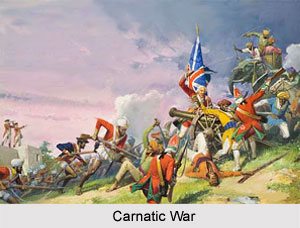 The Carnatic cost is a region in South India, lying within the Eastern Ghats and the Coromandel Coast. Carnatic region stretches in the states of Tamil Nadu, south-eastern Karnataka and southern Andhra Pradesh. Owing to the region`s prime position by the sea, it was always easy to attack in the open. This was a crucial reason for the commencement of the Carnatic war, as British and French naval forces were at loggerheads.
The Carnatic cost is a region in South India, lying within the Eastern Ghats and the Coromandel Coast. Carnatic region stretches in the states of Tamil Nadu, south-eastern Karnataka and southern Andhra Pradesh. Owing to the region`s prime position by the sea, it was always easy to attack in the open. This was a crucial reason for the commencement of the Carnatic war, as British and French naval forces were at loggerheads.
On 29th April 1758, the British Vice Admiral of Fort St. David, George Pocock (1706-1792) engaged the naval forces of French Admiral Comte Antoine d`Ache (d.1775). Although the results appeared uncertain, yet, the French lost 600 men, either killed or wounded. British casualty was over 100. On 4th May, the French captured the British possession of Cuddalore.
On 2nd June, the British East India Company`s station at Fort St. David fell to the French forces of the Comte de Lally (1700-1766) without putting up much resistance. The garrison at the nearby Devi-Cotah similarly fell to the French. On 24th June, Marquis de Bussey (1718-1785) expanded French interests in the Circars by his capture of three East India Company stations, including Vishakhapatnam and its fort. Control of Vishakhapatnam gave the French dominance of its important cloth weaving manufactures. However, on October 20, Colonel Francis Forde (d.1770) recaptured the city for the Company.
On 3rd August, Pocock and d`Ache engaged in a fight in a second inconclusive naval conflict off the coast of Nagapatam (presently Nagapattinam, Tamil Nadu). The French suffered about 500 casualties and the British 200. D`Ache, however, soon departed for the Coromandel Coast for repairs and re-supply at the Isle de France.
On 7th December, Colonel Forde (d. 1770) defeated the French led by the Marquis de Conflans at Condore, north of Rajahmundry.
During the extensive period of 14th December 1758 to 15th February 1759, the French besieged Madras. The regimental force was commanded by Lally. By design, the British withdrew from all its outposts, except at Chingleput. They had concentrated their forces in Fort St. George at Madras. Without control of the sea and with British forces at Chingleput and Trichinopoly (presently Tiruchirapalli in Tamil Nadu) threatening their rear, the French withdrew fast. The primary reason behind the French withdrawal was the arrival of Admiral Pocock from Bombay with British reinforcements. In the course of the siege, the British took 468 casualties.
Between the period of 25th March and 8th April 1759, Colonel Forde held Masulipatam under siege. On April 7-8, he attacked and forced Conflans to surrender. A treaty sign on May 14 with Salabat Jang (d.1763) provided for the replacement of French with British interest in the Masulipatam region. This ensured British control over the Northern Circars. On 28th May, the East India Company`s forces captured by direct assault from the French, the post at Conjeveram (present day Kanchipuram district, Tamil Nadu).
For the third time, on 10th September, Pocock and d`Ache met in a naval clash near Trincomalee. On this occasion the French held the advantage of eleven ships-of-war to the British number of seven. The French, however, suffered 886 men killed and wounded and left for Pondicherry for refitting. The British lost 569 men, but retained control of the seas off the Coromandel Coast.
With a British contingent, Major Cholmondey Brereton attacked the French forces at Wandlwash on 29th September. The attack failed and the British suffered the loss of over 200 men.
On 22nd January 1760, Sir Eyre Coote (1726-1783), Commander of the Madras Army, decisively beat the French general Comte de Lally (1700-1766) at the battle of Wandiwash. The French commander, Lally, was wounded and Marquis de Bussy (1718-1785) taken prisoner. On 15 January 1761, after a lengthy siege Coote captured the French possession of Pondicherry by starving them into submission. Hence, the British wrapped up the Carnatic War employing cunning moves and deft distribution of armed forces.






































